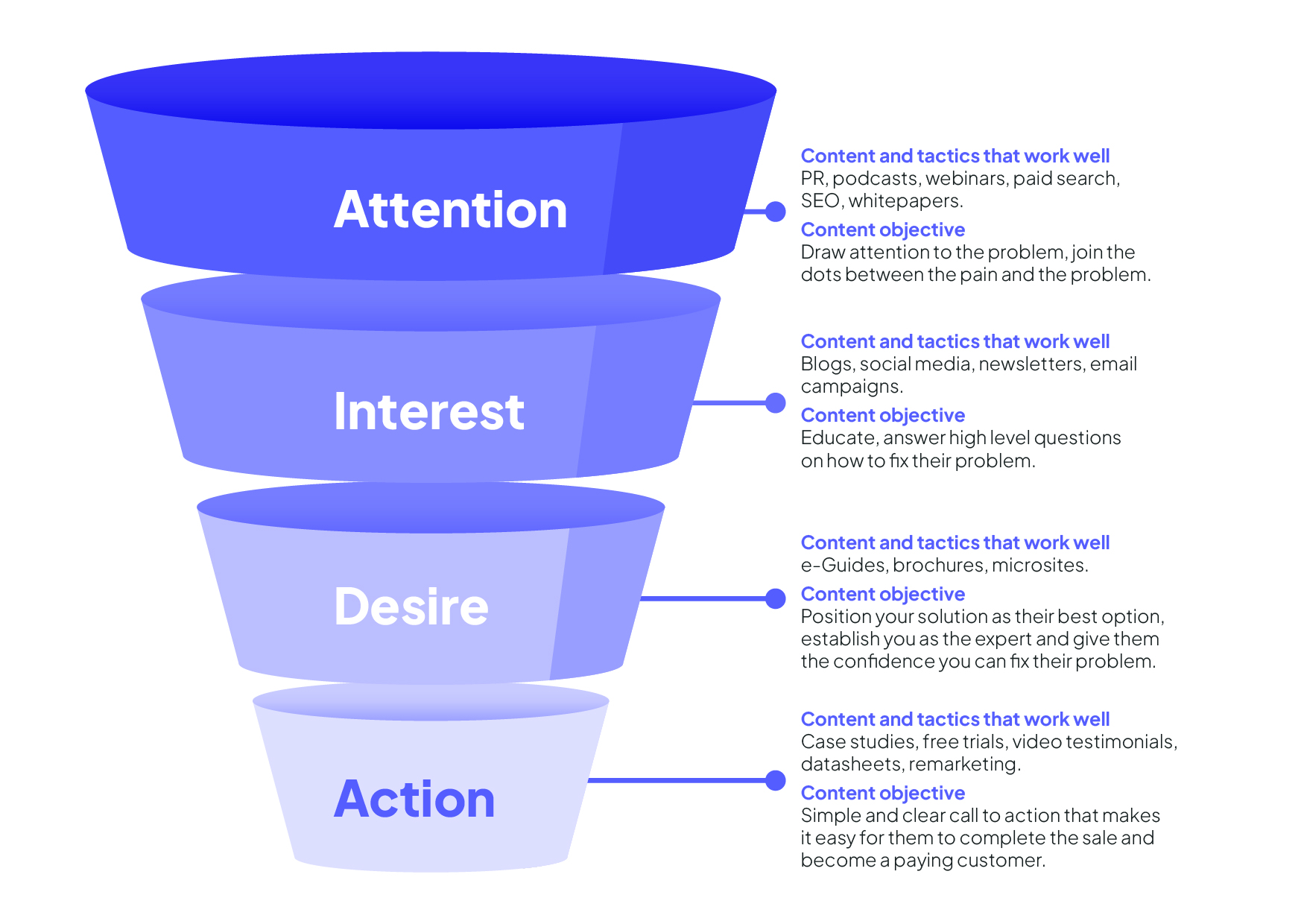The concept of the “marketing funnel” has been around for a long time, but with the changing landscape of buyer behaviour, particularly over the last 3-4 years, it’s worth reassessing how it operates today.
In recent years, the buyer journey has undergone considerable transformation. Decision-makers are now conducting more independent research, interacting with multiple touchpoints before engaging with sales, and expecting personalised, digital-first experiences. In fact, recent research from 6sense reveals that B2B buyers now spend 70% of their journey researching online independently before speaking with sales reps. This ‘dark funnel’ phase highlights the importance of brand awareness and consideration to influence buyers early in their decision-making.
Although the funnel has become more complex, breaking down the buyer journey and using a clear framework to understand it provides brands with more opportunities to engage buyers through the right channels at the right time.
Is the funnel still relevant, really?
Many marketing influencers suggest that the funnel is outdated, but we believe it remains a powerful tool to map how and when you can influence the buyer’s journey.
We are also long past the point where marketers view the funnel as a predictable, linear process. We all know buyers move through a more fluid, complex journey and that the funnel is ultimately a simplified view of something more complex.
The funnel’s purpose is to help marketing and sales teams be targeted.
For example, 62% of technology buyers feel B2B advertising is often too vague and not matching their needs. The funnel should be viewed as a framework for achieving greater specificity in message/channel and format.
The funnel is also a valuable framework for aligning sales and marketing. Everything marketing does should contribute to overall business objectives. A well-structured funnel ensures both sales and marketing are working toward the same goals and share the same understanding of the buyer journey.
What insights should drive your funnel understanding?
1. Digital-first buyer preferences
Understanding general trends in how buyers prefer to engage is a good place to start.
Even before the pandemic, buyer expectations shifted towards digital-first engagement. Many B2B buyers prefer to conduct research independently, often before contacting a sales team. A recent survey by 6sense revealed that 70% of the software buyer’s journey is spent on third-party research. This means brands must create self-service experiences, like webinars, product demos, or calculators, while also integrating human interaction at critical points to support decision-making.
Practical application:
Ensure your funnel supports both self-directed buyers and those needing personalised attention. Offering rich content and live interaction options can help bridge the gap.
2. Using real-time data to create a feedback loop
With more data available than ever, successful funnels are those that continuously evolve based on real-time insights. Analysing key metrics such as conversion rates, content engagement, and drop-off points can help you identify where prospects may be stalling in their journey. Understanding these insights allows you to tailor content or adjust the buyer experience to meet their evolving needs.
Practical application:
Regularly review funnel performance and adjust touchpoints lacking buyer engagement. Focus on addressing the core concerns influencing purchasing decisions, such as security or ease of use.
3. Addressing economic uncertainty
In the current economic climate, budget concerns and risk aversion increasingly influence buyer behaviour, leading to caution and reticence. This adds additional friction to buyer journeys and leads to slower lead/deal velocity. The right message at the right time has never been so important.
However, it’s also worth noting that LinkedIn’s research suggests 71% of technology buyers view technology as a source of growth, not just a cost. This mindset shift emphasises the importance of framing your solution as a tool for long-term business value, not merely an expense.
Practical application:
Throughout your funnel, focus on clear value propositions that emphasise measurable business impact. Use case studies, ROI calculators, and customer testimonials to reinforce your solution’s tangible value.
4. Knowing your customer
To effectively engage prospects throughout the funnel, you must first identify your target customer and define your Ideal Customer Profile. Understanding your ICP is the foundation of any good marketing strategy, as it helps you focus your marketing efforts on the prospects most likely to convert and benefit from your solution. Once you’ve established this, you can dive deeper into their buying journey.
While data and analytics (think website data, product use data) can provide valuable insights, asking customers directly about their buying experience can reveal gaps in your current strategy.
Practical application:
Conduct regular customer research to fill knowledge gaps about their buying journey. Use qualitative interviews to capture nuanced insights and quantitative surveys to track broader trends. Incorporate these insights to refine your funnel understanding.
How to structure your funnel
There are many variations of the marketing funnel, truthfully, no single version works perfectly for every business.
That said, we strongly recommend the proven AIDA model (Attention, Interest, Desire and Action). This model has consistently helped marketers structure how they guide prospects through each stage of the buying journey.

However, the real value of the funnel doesn’t lie in the specific framework itself. The framework is there to help you organise channels, activities and touchpoints, ensuring they align with buyer needs, preferences, and behaviours. The true value of the funnel is in how effectively you fill in the gaps with the right information and insights.
To be effective, your funnel should provide a clear, customer-centric picture of how you can influence buyers and their decision-making process. It should be driven by customer insights, ingesting data and feedback from your target audience to help you understand their journey and ensure your activities are aligned with their needs.
Your funnel is only as strong as your understanding of the buyer, get that right, and the rest will follow.
Need help getting started with your demand generation? Or perhaps you’ve got some of your strategy in place but it’s not quite performing as you’d like? Either way, we can help! Get in touch to chat with one of our team.

Jamie MacDow, Head of Client Services
Jamie MacDow, Head of Client Services at onebite, is a strategic and creative problem solver with over 30 years agency-side experience in the marketing and creative industry. During this time, Jamie has won many awards for his client-focussed solutions across the B2Bs, ANAs, UK Content Awards…amongst others.
As well as being a Founding Member of MarketReach by Royal Mail, Jamie has given talks to British Ambassadors, spoken on webinars and podcasts, and created content around our beloved marketing landscape. Somehow, in between all of this, Jamie has also realised a life-long dream and written a fiction novel. Today, Jamie is as focussed on helping brands, big and yet-to-be-big, solve their challenges as he is on agency growth and team happiness.




